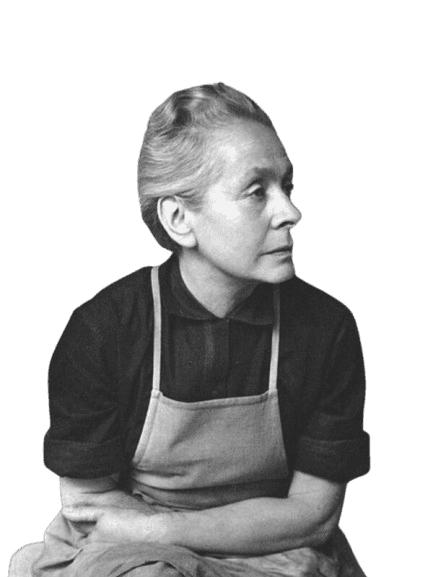Life and achievements
Early life
Lucie Rie, born Lucie Gomperz on March 16, 1902, in Vienna, Austria, was born into an intellectual and wealthy Jewish family. Her father was a medical doctor and a close friend of Sigmund Freud; therefore, Lucie was exposed to liberal culture.
Rie was inspired to do art at a tender age and took a liking to ceramics; she studied at the Kunstgewerbeschule in Vienna. Michael Powolny was her mentor in the technical aspects of pottery, and under his tutelage, she learned how to throw on the wheel and about glazes.
Modernist art of Vienna inspired Rie early in her career, and the Wiener Werkstätte movement greatly emphasized craft and design. By 1925, Rie had set up her studio in Vienna and soon achieved success with her new and unique ideas in pottery.
Her works during this period were rather austere, and the colour scheme was limited; Neoclassicism and Japonism inspired her. However, the political environment in Europe changed the course of her life drastically.
After the Nazis seized power in Austria in the year 1938, Rie escaped to London with some of her ceramics. In England, the task that she had to accomplish was the reinvention of herself as an artist, which also meant that she had to find a new place for herself in the British pottery market while at the same time trying to establish herself as a modernist potter.
Legacy
Lucie Rie's work and life can be summarized as a combination of artistry and strength. Having escaped Nazi persecution and arriving in London, she rose to become one of the leading ceramicists in the twentieth century.
Her work revolutionized studio pottery in Britain and shifted from the rustic Anglo-Japanese styles that dominated the market at the time towards the modernist style. Rie's ceramics, with their smooth, unadorned shapes, bright glazes, and sharp sgraffito designs, contrasted with her peers' more robust, practical-looking ceramics.
Her association with Hans Coper solidified her position in the post-war British art movement, and the duo's art was often displayed side by side. In addition to her artworks, Rie's technical contributions, especially in glaze formulation and firing, distinguished her from most of her contemporaries.
Her talent to achieve harmony between form and function, between simplicity and complexity, was highly appreciated. She was awarded the title Dame Commander of the Order of the British Empire (DBE) in 1991.
Camberwell College of Arts: From 1960 to 1972, Rie worked as a teacher at Camberwell College of Arts, where she imparted knowledge to young potters. Today, her works are in museums in Great Britain, the USA, Germany, and other countries, such as the Victoria and Albert Museum, the Museum of Modern Art in New York, and the Carnegie Museum of Art.
Milestone moments
Jul 21, 1925
First Studio in Vienna
Ceramicist Lucie Rie started her first pottery studio in Vienna in 1925 and continued her career as a ceramicist.
This studio became a place of inspiration, where Rie started to create her unique pieces based on Neoclassicism and Japonism.
At this time, she tried herself in the sphere of form and colour, creating pieces considered modernist in their simplicity and accuracy.
Rie's success in Vienna at the beginning of her career was followed by her international recognition as her unique style of pottery became increasingly popular.
Jul 11, 1937
Silver Medal at the Paris International Exhibition
In 1937, Rie received a silver medal at the Paris International Exhibition for her excellent ceramic pieces.
This accomplishment established her as one of the most prominent figures in the European ceramics movement, demonstrating her capacity to integrate practicality with aesthetic sophistication.
Her creations were well-shaped and well-fired, contrasting with the other traditional potters of her time, who had more of a modernist outlook.
Rie's award at this event made her famous and brought her career to an international level.
Mar 6, 1938
Emigration to England
After the Nazi regime annexed Austria in 1938, Rie left for London and left behind a well-established career in Vienna.
In London, she had to start again, and for a while, she survived by making ceramic buttons and jewellery.
Nevertheless, Rie persisted in perfecting her pottery works and exploring glazes and shapes that would characterize her later practice.
This decision can be considered a pivotal moment in Rie's life, as she changed from a successful Viennese potter to one of the most significant figures in British studio pottery.
Jan 25, 1946
Collaboration with Hans Coper
In 1946, Rie started a long relationship with Hans Coper, a young German-born potter who had never worked with pottery.
Together, they created extraordinary ceramics, which marry Rie's elegant design and Coper's sculptural approach to pottery in the framework of modernist art.
They were together as a couple for more than ten years, and in this period, they presented their artworks and became famous worldwide.
This cooperation was crucial for Rie's career as it allowed her to develop new directions in her work while maintaining her unique vision of the ceramics world.
